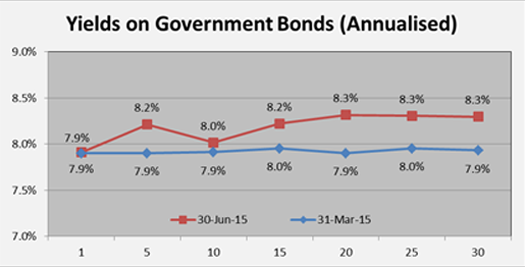Discount Rate for Actuarial Valuations of Employee Benefits (June 2015)
From Actuary's Desk
Discount Rate for Actuarial Valuations of Employee Benefits
(June 2015)
The discount rate used in actuarial valuations of employee benefit plans such as gratuity, pension, earned leave etc. is determined by reference to market yields at the balance sheet date on government bonds (refer Para 78 of AS15).
This above means that these valuations are essentially Mark-To-Market (MTM) valuations, which can result in fluctuations in the valuation of liability if the underlying yield on government bonds fluctuates. As can be seen from the below analysis, the yield on the government bonds as at 30 June 2015 has risen marginally compared to yields as at 31 March 2015.
Bond Yields as at June 2015 and March 2015
Yields on the government bonds (and consequently discount rates) have marginally risen during the first quarter of this financial year. .
The chart below presents the comparison of interest rates on government bond yields of various terms as at 30 June 2015 and 31 March 2015. This information can be used to determine the discount rate to be used for actuarial valuation as per AS15.

*Please note that the yields provided in chart above are interpolated yields in cases where a bond of exact term to maturity is not available. Please note that the government bond yields are quoted on semi-annual basis and yields in above chart have been annualised.
Source: www.ccilindia.com
The likely impact of rise in Bond Yields
As can be noticed, the yields on long duration bonds as at 30 June 2015 have risen by about 0.3% p.a. compared to 31 March 2015.
This rise in bond yields will translate into a rise in discount rate used in actuarial valuations, which is likely to result in actuarial gain due to change in assumptions and hence decrease in valuation of liability. The decrease in liability because of the above rise in yields is likely to be 2% to 4% of opening liability.
Without any corresponding offsetting movement on the assets side (remember, AS15 plan assets are also supposed to be valued at fair value), the positive impact of rise in discount rates and consequent decrease in liability will help marginally reduce the overall expenses for the quarter (which also include the usual interest cost, current service cost and other actuarial gains / losses).

Consistent movement in Salary Growth Rate
In each of our discount rate updates, we have been recommending a consistent movement in the discount rate and salary growth rate to reflect the positive correlation between the inflation component of salary growth rate as well as the discount rate.
Such a movement is also in line with the requirements of Para 76 of AS15, which reads as under:
"Actuarial assumptions are mutually compatible if they reflect the economic relationships between factors such as inflation, rates of salary increase, the return on plan assets and discount rates. For example, all assumptions which depend on a particular inflation level (such as assumptions about interest rates and salary and benefit increases) in any given future period assume the same inflation level in that period."
The Companies may, thus, consider strengthening the salary growth rate by a similar magnitude as is the movement in discount rate. This will help in offsetting the one off impact on expense of fluctuation in the discount rate.
I trust you will find the observations and assertions in this note useful. I thank you for reading this note and welcome any comments or recommendations or observations you may have on the subject. You can direct those to the email address mentioned below.
Arpaan Begdai
Senior Manager - Actuarial
a.begdai@kpac.co.in
+91-9899824848

